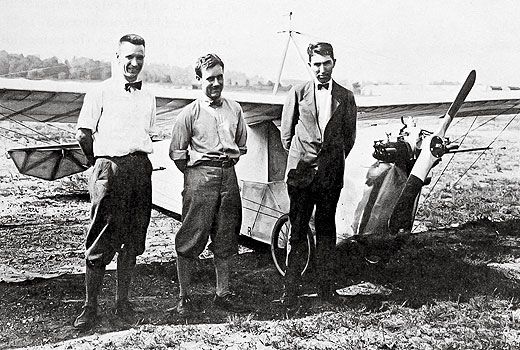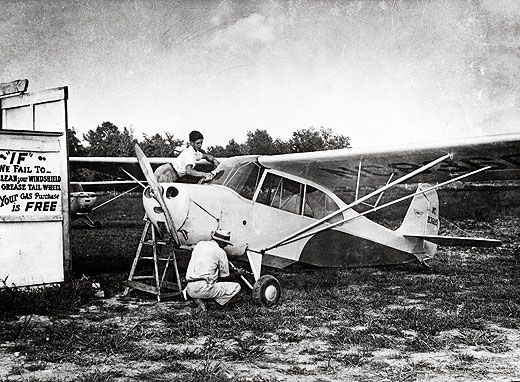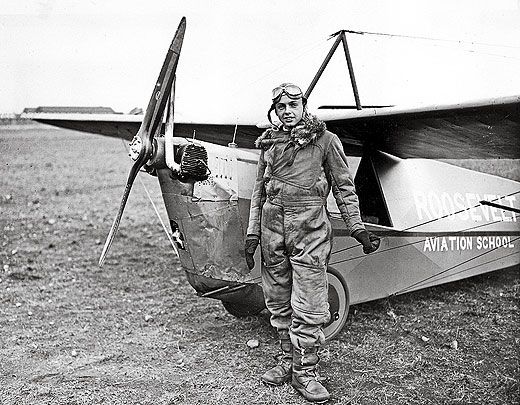Flying Bathtubs Sell Like Hotcakes
The nation’s first mass-produced lightplane started as a homely, humble homebuilt.
/https://tf-cmsv2-smithsonianmag-media.s3.amazonaws.com/filer/Flying_Bathtubs_FLASH.jpg)
Even during the early years of flight, when aircraft design was influenced as much by whimsy as by aerodynamics, Jean Alfred Roche’s serious little airplane was considered comic-looking.
Its bluntly tapered front end and button nose cleaved the air just forward of a low-side open cockpit in which the pilot essentially sat on the floor, leading some wag to christen it the Flying Bathtub. One can easily imagine a cartoon character sailing along in it, merrily scrubbing his back, soapsuds spilling out.
Appearances notwithstanding, the squat little aircraft launched a company and spawned a market for simple, lightweight airplanes for Everyman.
Jean Roche surely was the least surprised of anyone by the airplane’s success. The Aeronca C-2 was the culmination of his vision for a cheap and easy-to-fly airplane. As the Great Depression settled in, sales of the C-2 took off, buoyed by the craft’s affordability—under $1,500—and its quirky spirit.
Of 164 C-2s sold in 1930 and ’31, just 15 or so are still around—the “or so” covering the ones in pieces. Several fully restored C-2s are in museums. Only a handful are flying, and at least one is about to.
IN 1956, chance led Bill Smela, an 18-year-old airport apprentice, to a damaged C-2 for sale. He bought the airplane for $600, but didn’t get around to repairing it until two years later. When he was nearly done, a friend’s wife backed a car into it. The mishap would ground the Aeronca for another 50 years.
Smela and his wife, Mary Jo, operated a succession of small airports, and he restored several aircraft, but the C-2 remained untouched. Finally, in 1997, Smela let it go. Dean Kramer, a United Airlines pilot from Bernville, Pennsylvania, called, and Smela first tried to sell him another aircraft. Unsuccessful, he reluctantly said, “I have one other plane you might be interested in: a Flying Bathtub.”
Smela now works intermittently at restoring the aircraft for Kramer. “The deal we cut is that he does the restoration, and he gets to take the first flight,” Kramer says. For now, the airplane sits inside an 18th century stone building behind Smela’s New Jersey home.
Ten years after Smela bought the Aeronca, when he was working at an airport in Pennington, New Jersey, in exchange for flying lessons, he had an unexpected visit from the designer himself, Jean Roche. “I understand you have an Aeronca,” Smela recalls Roche saying, by way of introduction. He then reminisced at length about the airplane, which he had created more than 40 years earlier.
“He pointed at the gas tank and said, ‘See that? That’s a mailbox,’ ” Smela recalls. Roche explained that when he and his partner needed a gas tank, they soldered shut a mailbox, cut a hole in the top, capped the opening, and hung the box in place.
JEAN ROCHE WAS 12 when he and his family arrived in New York from France in 1906. At age 17, after tinkering with model aircraft and gliders, Roche applied for the first of what would be 20 patents. Four years later, he earned an engineering degree from Columbia University and began designing aircraft for a living. In 1917, the U.S. Army Signal Corps’ Aviation Section settled at McCook Field in southwest Ohio, and Roche with it.
McCook housed the first center for research on military aviation. Nearby Dayton was home to the Wright brothers. All this inventiveness fueled company start-ups and home-based airplane projects alike. In a garage at 28 Watts Street, Roche and McCook colleague John Q. Dohse pieced together what they called the Roche-Dohse Flying Flivver.
This was to be a personal aircraft: It weighed about 400 pounds and measured 20 feet nose to tail, with a single, high wing spanning 36 feet. Behind the cockpit, the sides of the cotton-fabric-covered fuselage converged in a narrow spine, which ran from the trailing edge of the wing to the base of the vertical stabilizer. The triangle-shaped fabric enclosing the area behind the pilot’s seat was reminiscent of a pup tent. This distinctive “razorback” body was modified to a more rounded appearance in later Aeronca models.
A tubular bipod jutted above the cockpit with hanging wires running to each wing, supporting the wings when at rest. Two sets of streamlined flying wires connected the underside of each wing to the fuselage, anchoring the wings in flight.
There was no windshield or brakes (to slow the aircraft, the pilot had to reach out with gloved hand and grab a tire), and only meager instrumentation. The cockpit had a plywood seat, a stick to move the ailerons and elevators, and a foot-operated rudder bar that pivoted like the steering mechanism on a child’s sled. Spoked buggy tires carried the forward fuselage; the tail sat on a metal skid. An engine eventually would sit at the apex of the aircraft’s slanted front end. But first, Roche had to find an engine.
He tried one from a Henderson motorcycle, the fastest bikes of the era, but the four-cylinder engine could not get the airplane off the ground. Roche then asked another McCook colleague, Harold Morehouse, to build a suitable powerplant. In 1925, the airplane was fitted with Morehouse’s new 29-horsepower, two-cylinder gasoline engine and moved to nearby Wilbur Wright Field for testing.
During a September 1 taxiing test, Dohse inadvertently gave the Morehouse too much throttle and the airplane lifted off. Finding himself in the air, Dohse decided to stay there. He climbed and circled, then landed. After backslapping, the trio went back to work. Some 200 flight tests followed.
A crackup in 1926 destroyed the Morehouse engine. Morehouse had left McCook, so Roche turned to two other Army engineers, Robert Galloway and Roy Poole, who built a 107-cubic-inch, two-cylinder engine producing 26 horsepower. It became the aircraft’s standard powerplant.
In November 1928, several business and political luminaries—among them Dow Chemical and Drug Company executive I.C. Keller and eventual U.S. Senator Robert A. Taft—formed the Aeronautical Corporation of America in Cincinnati and scouted around for an airplane. Their search took them to Wright Field the following spring for a demonstration of what by then was more soberly called the Roche Original. While Dohse put the Original through its paces, Roche plied the watching VIPs with his aeronautical knowledge. Aeronca (the shortened corporate name became official in 1941) had its airplane.
Except for being fitted with a windshield and overhead windows and having its assembly modified for mass production, the prototype emerged from the adoption process virtually intact—except now it was called the Aeronca C-2.
BY THE LIGHT of a battery-powered lantern, Edward Wynkoop Stitt squinted at an unscrolled map in his lap. It was July 1937, and Stitt had taken off in his C-2 from Columbus, Ohio, with an extra 30-gallon fuel tank behind his seat.
He was trying for a light-airplane distance record, but for two days the C-2 had bucked strong westerly winds. Night had fallen and Stitt was having difficulty holding a fix on an airmail route beacon. Headwinds kept the little airplane more or less hovering. Furthermore, the C-2’s engine was sputtering. Stitt unknowingly was pumping too much oil into it from a reservoir next to his seat and fouling its sparkplugs.
As he leaned out into the night for another look ahead, his attention was drawn to an iridescent field amid dark timberland. An open area of prairie grass shimmered tantalizingly. The weary Stitt conceded defeat. He descended to the field, realizing too late that among the tall grass were scattered tree stumps. The rolling C-2 struck one and flipped. The damage to airplane and pilot was minimal.
At dawn, Stitt elected to stay with the downed machine. The next day, low on water, he ventured into the surrounding woods and came across a man riding a horse-drawn log. He hailed the startled woodcutter and rode the log toward civilization, which turned out to be Booneville, Iowa.
Stitt had set a new National Aeronautic Association-verified distance mark for light aircraft, having flown almost 584 miles, eclipsing the 449 miles he had logged in a flight two years before. Still, he was chagrined. He had landed with at least 10 gallons of fuel remaining. With better luck, he could have gone on, making it all the way to, say, Omaha.
Stitt told that story in 1956 to an 18-year-old Bill Smela, who had come to his auto upholstery shop near Trenton, New Jersey, to price a new top for his Model A Ford roadster pickup and was drawn to a photo of Stitt standing by an airplane. Shortly thereafter, Smela came back with $600 and bought the C-2.
EVEN DISASSEMBLED, the C-2 has tales, which Smela tells as he walks among the pieces in his shop. The lower portion of the airplane’s aluminum cowling, which Smela has replicated, was missing after being battered by, perhaps, an Iowa tree stump. Smela fingers a reinforced fuselage strut that had been fractured, possibly in that same adventurous landing. He was told that the two pistons in the E107-A engine were manufactured by the Indian Motorcycle Company. The engine’s cam lifters are stamped “Buick.” In 1930, airplane engines used both original engineering and gleaned parts.
Smela once actually flew a C-2—not his own. “It almost flew itself,” he recalls. Mike Haynes, an Alabama pilot, pretty much concurs. Haynes specializes in restoring aircraft and other antique machinery, and calls the C-2 “very easy to fly, very forgiving, very docile.”
It climbs slowly, Haynes acknowledges, “but once you get it up there and are cruising above the trees, it is a delight to fly. If it is trimmed out, you can take your hands off the controls and steer with the rudder. That’s what makes it joyous to fly, just looking around at everything, seeing the deer run in the woods.”
The C-2’s wing and fuselage proportions are akin to those of a glider—Jean Roche’s first love—but Haynes says it really is “a power airplane. I had to carry 1,900 rpm [engine power] or else it was coming down.”
The glide rate might have been affected by the size of the pilot. Haynes says when a C-2 hauled around his 230 pounds, he couldn’t land slower than 45 mph; a lighter friend consistently landed at 35 mph.
At six feet four, Rick Durden jokes that when he clambers past the flying wires and into the little Aeronca, it is not a “graceful” sight.
Durden flies numerous modern and vintage aircraft. The Coloradan has logged more than 7,000 hours aloft, some of it in open-cockpit Aeroncas. “If you have flown anything in that era, you realize they didn’t understand anything about stability and control,” he says. “Control harmony didn’t exist. Stability didn’t exist. This [C-2] was a big step forward for the time. It might not be the best today, but it was so much better than anything else then.” Genealogically speaking, Durden says the C-2 “begat” some of the classics of general aviation: Taylorcrafts, Piper J-3 Cubs, and Aeronca Champions.
“What is phenomenal about the aircraft is that the engineering that went into it is so elegant,” says Craig MacVeigh of Seattle. MacVeigh owns 11 Aeroncas, including a recently purchased C-2. He is a board member of the National Aeronca Association; a board peer affectionately calls the ex-Marine Corps aircraft maintenance officer “our resident C-2 nut.” MacVeigh also has a pair of C-3s, the C-2’s two-place successor.
“The plane wasn’t just something that Roche slapped together from a 1910 Popular Mechanics magazine,” MacVeigh continues. “He did some very, very serious engineering, efficient engineering.”
Bob Hollenbaugh, an Aeronca engineer for 40 years, says, “The C-2 and C-3 and virtually all Aeroncas were configured with two lower longerons and one upper longeron. They used the triangular fuselage because structurally it was a better configuration, stronger than a box type.”
Three longerons—the fuselage’s primary longitudinal members—indeed were a genetic marker for Aeroncas. The signature framework remained even after wooden stringers were attached to later models to soften the lines for aesthetic and aerodynamic reasons. The C-2’s lineage, in other words, is in the bone structure.
After producing more than 17,000 airplanes in 55 models, Aeronca quit in 1951, turning to components for commercial and military aircraft, missiles, and space vehicles. In July 2008, Aeronca, which had been acquired by Magellan Aerospace in 1986, was awarded the contract to develop heat shields for NASA’s new Orion crew exploration vehicle. If the contract is not canceled in a shift of priorities for the space agency, Aeronca will build the shields in its Middletown, Ohio facility, where, since it relocated there in 1940, it produced more than 10,000 of the Flying Bathtub’s most famous successor, the Aeronca Champion.
Giles Lambertson became acquainted with the Aeronca C-2 because his father learned to fly in one.


